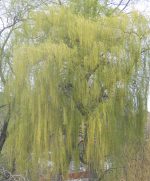
This weeping deciduous tree is a cross between Salix babylonica that proived the weeping habit and Salix alba ‘Vitellina’ that provided frost hardiness and golden shoots. Salix is a member of the willow family, Salicaceae, that also includes aspen, cottonwood, and poplar. The trees grow up to 70′ tall and 50′ wide and have arching branches ending in golden-yellow branchlets. The glossy green leaves are lanceolate and turn golden yellow in the fall. Unlike most willows, inconspicuous male and female flowers are usually produced in the same catkins in mid spring. Golden weeping willow is a very beautiful picturesque tree and looks especially well on the edge of a pond or lake where its reflection can add to the scene. It is very tolerant of urban pollution but is short-lived, messy, and not suitable for small gardens or planted near buildings because of potentially invasive roots. The genus name, Salix, is the ancient Latin name for one of the species. The specific epithet, sepulcralis, is the Latin word meaning growing in burial places.
Type: Deciduous tree
Outstanding Feature: Weeping habit; golden branchlets
Form: Rounded, weeping
Growth Rate: Rapid
Bloom: Inconspicuous male and female flowers in the same catkin, in mid spring
Size: 40-70′ H x 30-50′
Light: Full sun
Soil: Average, medium moist to wet; tolerates lean soil.
Hardiness: Zones 5-9
Care: Clean up branch and leaf litter as it accumalates.
Pests and Diseases: Aphids, caterpillars, gall mites, nematodes, sawfly larvae, stem borers; anthracnose, canker, crown gall, honey fungus, powdery mildew, root rot, rust, scab
Propagation: Softwood cuttings in early summer, hardwood cuttings in winter
Photo Credit:Wikimedia